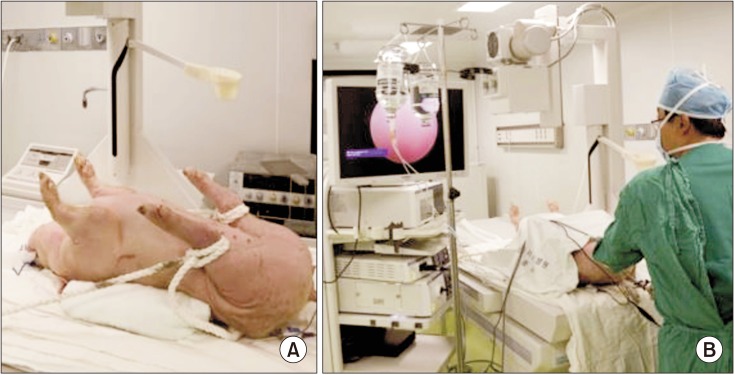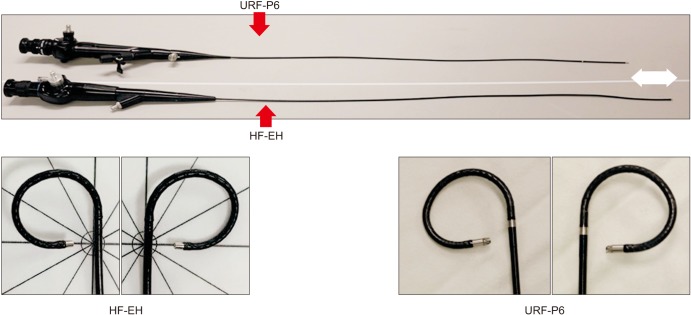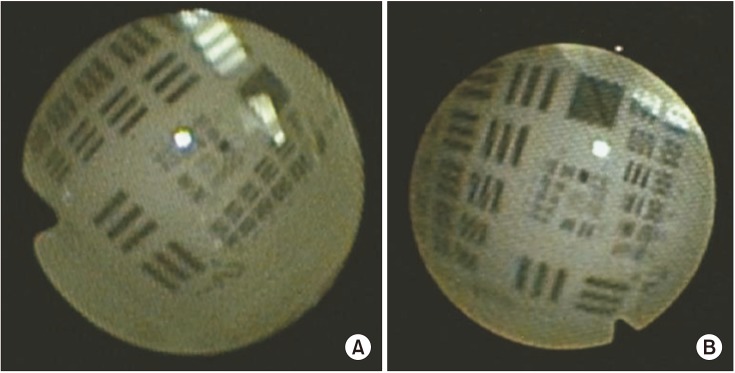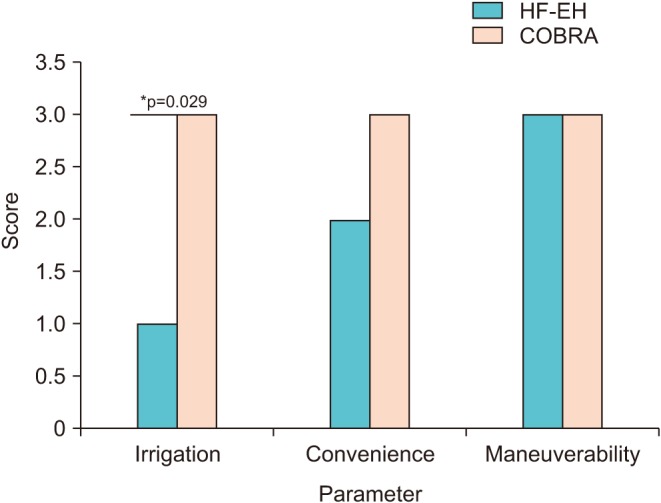Investig Clin Urol.
2018 Sep;59(5):328-334. 10.4111/icu.2018.59.5.328.
In vitro, in vivo, and clinical tests of a novel flexible ureteroscope for the diagnosis and treatment of kidney and ureteral diseases
- Affiliations
-
- 1Department of Urology, Asan Medical Center, University of Ulsan College of Medicine, Seoul, Korea. hkpark@amc.seoul.kr
- KMID: 2419416
- DOI: http://doi.org/10.4111/icu.2018.59.5.328
Abstract
- PURPOSE
Despite advances in flexible ureteroscopy, the high cost and long repair time of ureteroscopes limit their use in the urology. We compared the performance of a novel flexible ureteroscope (fURS) "˜HF-EH' with that of the two contemporary fURSs "˜URF-P6' and "˜COBRA'.
MATERIALS AND METHODS
We compared in vitro measurements of deflection angle, irrigation flow rate, and image quality between HF-EH and URF-P6 while also inspecting renal collecting systems in five female pigs. For clinical testing, we performed retrograde intrarenal surgeries using HF-EH in four patients. Experienced urologists compared performance parameters (irrigation, convenience, and maneuverability) between the HF-EH and COBRA.
RESULTS
The flow rate of HF-EH (21.0 mL/min) was worse, and its resolution (1.59 line pairs/mm) was inferior to that of URF-P6 (28.7 mL/min and 3.17 line pairs/mm, respectively). However, HF-EH was superior to URF-P6 in terms of loss of deflection angle with the insertion of accessories (1.8% vs. 12.7%). In vivo and clinical testing revealed that the performance parameters of HF-EH were slightly inferior to those of conventional domestic fURSs. We successfully performed retrograde intrarenal surgeries using HF-EH in four patients and achieved stone-free statuses in two. None of the patients exhibited any procedure-related complications.
CONCLUSIONS
Although we observed that two of the three performance parameters of the novel ureteroscope "˜HF-EH' were inferior to those of the conventional ureteroscope, we successfully used HF-EH to perform retrograde intrarenal surgeries in patients. Further studies on performance and durability are warranted for making HF-EH commercially available.
Keyword
MeSH Terms
Figure
Reference
-
2. Abdelshehid C, Ahlering MT, Chou D, Park HK, Basillote J, Lee D, et al. Comparison of flexible ureteroscopes: deflection, irrigant flow and optical characteristics. J Urol. 2005; 173:2017–2021. PMID: 15879808.
Article3. Cho SY. Current status of flexible ureteroscopy in urology. Korean J Urol. 2015; 56:680–688. PMID: 26495068.
Article4. Healthcare Bigdata Hub [Internet]. Wonju: Health Insurance Review & Assessment Service;2015. cited 2018 Jan 17. Available from: http://opendata.hira.or.kr/op/opc/olapDiagBhvInfo.do?tNum=7.5. Lee MC, Bariol SV. Evolution of stone management in Australia. BJU Int. 2011; 108(Suppl 2):29–33. PMID: 22085123.
Article6. Raheem OA, Mirheydar HS, Miller DL, Palazzi KL, Chang DC, Sur RL. Contemporary trends in the ambulatory surgical treatment of urolithiasis: population-based analysis. J Endourol. 2015; 29:1189–1192. PMID: 25849858.
Article7. Ordon M, Urbach D, Mamdani M, Saskin R, D'A Honey RJ, Pace KT. The surgical management of kidney stone disease: a population based time series analysis. J Urol. 2014; 192:1450–1456. PMID: 24866599.
Article8. Lusch A, Abdelshehid C, Hidas G, Osann KE, Okhunov Z, Mc-Dougall E, et al. In vitro and in vivo comparison of optics and performance of a distal sensor ureteroscope versus a standard fiberoptic ureteroscope. J Endourol. 2013; 27:896–902. PMID: 23402369.
Article9. Parkin J, Keeley FX Jr, Timoney AG. Flexible ureteroscopes: a user's guide. BJU Int. 2002; 90:640–643. PMID: 12410739.
Article10. Türk C, Petřík A, Sarica K, Seitz C, Skolarikos A, Straub M, et al. EAU guidelines on interventional treatment for urolithiasis. Eur Urol. 2016; 69:475–482. PMID: 26344917.
Article11. Tom WR, Wollin DA, Jiang R, Radvak D, Simmons WN, Preminger GM, et al. Next-generation single-use ureteroscopes: an in vitro comparison. J Endourol. 2017; 31:1301–1306. PMID: 28978227.
Article
- Full Text Links
- Actions
-
Cited
- CITED
-
- Close
- Share
- Similar articles
-
- ureteroscopic Stone Extraction ; 78 cases
- Effectiveness of Flexible Ureteroscopic Stone Removal for Treating Ureteral and Ipsilateral Renal Stones: A Single-Center Experience
- Treatment of Ureteral Calculi Using Rigid Ureteroscope
- Iatrogenic Ureteral Injuries during Radical Hysterectomy: A Review of 23 Cases
- Controversies associated with ureteral access sheath placement during ureteroscopy






